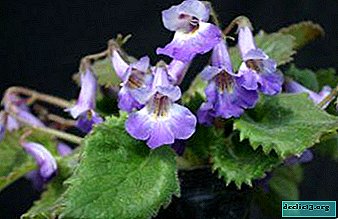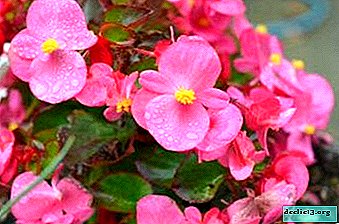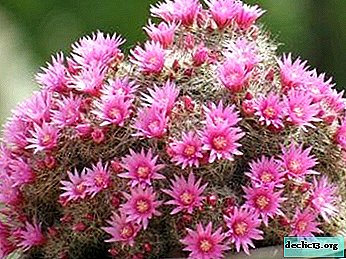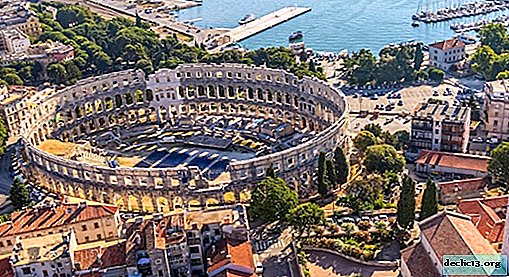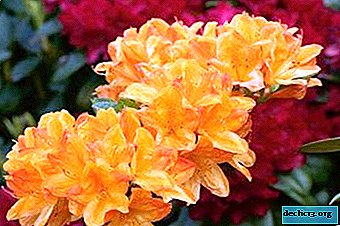Kilimanjaro Volcano - the highest mountain in Africa
In the north-eastern part of the African state of Tanzania, between the Serengeti and Tsavo national parks, is Mount Kilimanjaro, which gave the name of the only mountainous national park in Africa. By its size, the mountain competes with its counterparts on other continents: Kilimanjaro is the fourth highest mountain of the “seven peaks”. On the continent, she has no equal, so she rightfully received the nickname "the roof of Africa." In addition, Kilimanjaro is the largest free-standing mountain in the world: the length of the base reaches 97 km and its width is 64 km.
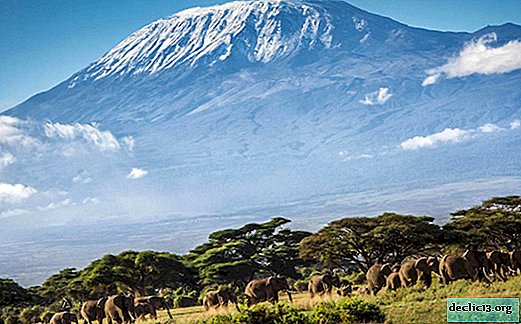
General information
The top of Mount Kilimanjaro consists of the extremities of three extinct volcanoes of different ages. The height of the mountain is 5895 meters, so it is not surprising that in its upper part the snow lies all year round. From the Swahili language, which is national in Tanzania, the word "kilimanjaro" in meaning is translated as "sparkling mountain." Local peoples, who traditionally inhabited the lands around Kilimanjaro volcano and never knew snow, believed that the mountain is covered with silver.

Geographically, Kilimanjaro is located very close to the equator line, however, large differences in the mountain peaks determined the change of climatic zones, which is expressed in the growth and settlement of species characteristic of areas of other latitudes. In fact, is Kilimanjaro an active volcano or extinct? This issue is sometimes debatable, since the youngest part of its geological origin sometimes shows signs of volcanic activity.

Another feature of Mount Kilimanjaro is the rapid melting of the snow cap. Over a hundred years of observation, the white cover has decreased by more than 80%, and over the past half century, the mountain of Africa has lost most of its glaciers. Remains of snow cover are available at two peaks, but they, according to experts, will be completely lost within the next 15 years. The reason scientists call global warming. Photos of Mount Kilimanjaro from different years of the last century eloquently demonstrate the reduction and gradual disappearance of white areas on the tops of the mountains.
Flora and fauna
The mountain slopes are covered with dense tropical forests and surrounded by endless African savannahs. The flora and fauna of Tanzania National Park is rich in species widespread in these places, as well as unique and endangered, for the preservation of which a reserve was created.

The large-scale territory of the mountain, both in height and in breadth, contains almost all the zones characteristic of the highland regions of Africa:
- the southern parts are covered with savannahs of different heights up to a mark of 1 thousand m and approximately at an altitude of one and a half km on the northern slopes;
- foothill forests;
- mountain forests - from 1.3 to 2.8 km;
- subalpine swampy meadows;
- Alpine tundra - the most extensive available in Africa;
- the mountain peaks are occupied by the alpine desert.

Forests located above 2,700 m are included in the protected area of the national park. The vegetation of Kilimanjaro volcano deserves special attention. There are many species that are characteristic of much more northern latitudes, as well as the oldest and fanciful plant forms. This is croton, calodendron in the forests of the northern and western parts of the mountain (at altitudes from 1500 to 2000 m), cassiporea is even more common. On the opposite slopes, ocotea (or East African camphor tree) occupies similar heights. In the areas above them there are rare tree-like ferns that are found 7-meter in size.

Mount Kilimanjaro is devoid of the belt of bamboo rainforest found in other similar highlands of Africa. The subalpine zone on different sides is covered with dense vegetation from hagenia and podocarpus. Alpine tundra differs sharply in its appearance and population of living organisms. Here prevail plants that are well adapted to harsh alpine conditions - heather, immortelle, adenocarpus, Kilimanjar sweat, waxwort, African myrsin, as well as numerous herbs from the hardy sedge family.

The fauna of Kilimanjaro volcano in Tanzania is no less diverse and amazing. One and a half hundred species of mammals - almost 90 of them inhabit forests. They include several groups of monkeys, dozens of species of predators, antelopes and bats. The most common in the forests: leopards, monkeys, galago, buffalos and others.
 Bearded man
Bearded manTwo hundred African elephants travel in the floodplains of the Namwai and Tarakiya rivers, periodically climbing to decent Kilimanjar heights. Where forests end, small insectivorous mammals live. The slopes of Kilimanjaro volcano are full of birds. Here, there are about 180 species of birds, of which: vulture-lamb, or bearded man, one-color modest coinage, Hunter cysticole, filamentous nectaria, white-chested raven.
Kilimanjaro Mountain Weather Conditions
The climatic zonality of the Kilimanjaro natural complex in Africa is reflected in temperature conditions and weather conditions in general. The rainy season is well expressed here, the weather is changeable, temperatures vary greatly at different heights, depending on the time of day. 28-30 ° С are typical for the base of the volcano, and already starting from three thousand meters and higher, frosts up to -15 ° С are typical. The following stable climatic zones are distinguished on the mountain slopes.

- The rainforest is characterized by a warm and humid environment. There is a lot of greenery, and the air warms up to comfortable 25 ° C during the day (an average of about 15 ° C).
- Africa’s mountain tundra contains almost no moisture, and several degrees less heat.
- Alpine desert will please winter lovers with initial minus temperatures, although in the daytime a temperature zero comfortable for these places is kept.
- The summit glaciers of Mount Kilimanjaro in Tanzania provide an average temperature of -6 ° C. Ice winds reign here, and frost can reach -20 ° C at night.

At different times of the year, depending on the slope and height, cloudiness of varying degrees, increased or moderate precipitation, thunderstorms are observed. All this affects the visibility and comfort of being on the slopes - Kilimanjaro volcano in Africa is a favorite place for climbing its colorful peaks.
Climbing Mount Kilimanjaro
It is believed that the peaks of Mount Kilimanjaro in Tanzania are accessible for conquest all year round. However, periods that are more convenient for climbing, difficult and even dangerous, are distinguished. The most suitable periods are from July to September and January-February. At this time, the weather conditions are most favorable, and the months coincide with the summer or New Year holidays of tourists. Mountain tours in Tanzania are accessible from various points at the foot. Usually they last from 5 to 8 days.

The routes are diverse due to the vastness of intersected territories, familiarity with the diversity and characteristics of each climatic zone. Tours to the highest points of the volcanic extremities end at the moment of sunrise, after which the return journey begins. There are 6 routes in total, mainly by the name of the settlements from which they originate:

- Marangu;
- Rongai;
- Umbwe
- Machame;
- Lemosho;
- North traverse.
As an additional route, an expedition to the crater is proposed.

Hiking in Tanzania is not done alone. Any mountain is a serious test for climbers, even with many years of experience. In addition, to conquer the mountain you need special equipment and equipment, the total weight of which is always better to share with someone. Despite the fact that climbing the mountain is possible both in the direction from Kenya (northern slope) and Tanzania, only Tanzanian routes were laid and serviced by agreement between the states. Kenyan slope is not equipped with the appropriate infrastructure.

In order to overcome all the difficulties and obstacles on the path to conquering the summit, it is necessary to comply with important conditions.
- Mandatory participation of the guide and assistants (at least 1-2 people), without them it is not possible to climb.
- Appropriate equipment, special shoes, thermal underwear (maybe more than one set), insulated and waterproof things.
- Sufficient physical fitness, hardened body, strong immunity, responsible attitude to health, competent distribution of energy and strength.

In addition, you will need food, personal hygiene products, items to ensure basic comfort. A complete list of what is required for climbing is available on the website of the company organizing tours in Tanzania. There is also a list of recommended things that you should have with you, but not necessary. So, you must have, in addition to clothes and warm clothes, a sleeping bag, sunglasses, a headlamp, tracking poles, a flask for water. In addition to this, the organizing company usually provides a tent, a tourist rug, dishes, camping furniture.
Estimated cost depends on the route, the duration of the climb, the number of people in the group, separately negotiated conditions. Amounts start at $ 1,350 (Marangu route, 8 days) and reach $ 4,265 (route for 1 person with an expedition to the crater). At the same time, one must also take into account where Mount Kilimanjaro is located - company service may include a transfer from Tanzania's airport or it will be necessary to get by yourself.Find out RATES or book any accommodation using this form
Some interesting facts

- Relative to other mountain peaks, Kilimanjaro volcano does not look like an insurmountable obstacle, however, only 40% of climbers reach its highest points.
- The mountain is submitted not only to absolutely healthy tourists: in 2009, 8 blind climbers were able to climb its peak, who helped to raise funds for 52 blind children with their action.
- The greatest climber on Kilimanjaro was 87 years old.
- Every year, about 20 thousand people make attempts to climb the mountain.
- Almost 10 people die here every year during the ascent.
Mount Kilimanjaro is not only a unique natural park full of amazing creatures, but also a real adventure. And in order to feel a surge of emotions, to become the owner of unforgettable impressions, to touch the majesty of Africa - for this you need to visit Tanzania and see for yourself the unsurpassed qualities of Kilimanjaro.



